Heating up
The Vermont Climate Council takes its show on the road
Page 3



Heating up
The Vermont Climate Council takes its show on the road
Page 3


LIBERTY DARR STAFF WRITER
As the legislative session winds down, some lawmakers aren’t slowing their strides in advocating for Vermonters who face threats and action from federal immigration authorities.
“I would start by saying the most important thing we can do as state legislators is raise awareness and help people know their rights and how those rights are under attack,” Senate Majority leader Kesha Ram Hinsdale, D-Chittenden-Southeast, said.
Senate Democratic leaders earlier this month urged Republican governor Phil Scott to terminate a memorandum of understanding the state has with U.S. Immigration and Customs Enforcement that allows federal detainees to be housed in stateowned prisons. The call came just
See LEGISLATORS on page 24



LIBERTY DARR STAFF WRITER
Parking in South Burlington’s city center — specifically places like Market Street and Garden Street — may soon not be free.
The city, since October, has been working with the Chittenden County Regional Planning Commission to develop a parking management strategy as the area shifts from a suburban area to a more urban one.
“As we think about downtowns and how to provide the municipal support to ensuring a vibrant downtown in the community’s vision, paid parking is something we need to implement to ensure that there are spaces available for folks who want to come in and go to one of the restaurants or go to the one of the shops,” city manager Jessie Baker said.
The city’s community development director, Ilona Blanchard, explained that while City Center is a downtown, it is also very much an area in transition. Historically, patterns for retail and businesses in the area have been limited to shopping centers and
See PARKING on page 20



LIBERTY DARR STAFF WRITER
The city of South Burlington has received a federal grant to complete a high-priority sidewalk project on Williston Road.
The Vermont Agency of Transportation last month announced the recipients of more than $11 million in federal funds for municipal grant projects through the Transportation Alternatives Program and Municipal Highways and Stormwater Mitigation Program.
South Burlington received $430,000 of it, which will help shape a project that has long been a priority for city officials. The Williston Road project involves building three different sidewalk segments, totaling 1,600 feet of new sidewalk, between Williston Road, Kennedy Drive and the Airport Drive intersection
Determining how residents move throughout the city has been a top priority for leaders for years and was outlined as a high impact action in the city’s first Climate Action Plan in 2022.
The plan sees a shift away from vehicle travel and toward more people-powered transportation modes as key in reaching the city’s climate goals of reducing vehicle miles traveled within the community by 2 percent a year.
“The goal of this is to close those gaps.”
— Erica Quallen
“There’s some kind of disconnected sidewalk segments that have been built as properties have done work and been required to build sidewalks, but there are three gaps,” Erica Quallen, deputy director of capital projects for the city said. “The fact that it’s disconnected on the section of Williston Road where folks really start to speed up renders those existing sections a bit useless, so the goal of this is to close those gaps.”
This is the sort of work that has been outlined in the city’s newly adopted active transportation plan, a comprehensive document detailing the vision, goals and strategic recommendations designed to advance all modes of getting around the city’s 16-plus square miles.
Through strategic planning, other policy initiatives and a historically strong commitment to implementing pedestrian and bicycle infrastructure projects, South Burlington has already laid the groundwork for a comprehensive network of active transportation infrastructure. For example, the city’s current active transportation network features approximately 13 miles of on-road bike lanes, 25 miles of shared-use paths and 50 miles of sidewalks. But it contains several gaps, like the ones on Williston Road, that make complete trips challenging for those who are walking and biking.
“The bike and ped committee was really instrumental in choosing this project as the preferred project to apply for the grant,” Quallen said. “That group really pushed for this. I had brought them a few options at the end of last when we were preparing for this grant, and this was the one from the options that they really supported.”
The city will be on the hook for just over $100,000 to match the grant, paid from the city’s Penny for Paths program, which levies one cent on the tax rate to create new bike and pedestrian infrastructure.
The Chittenden Solid Waste District has been awarded a $111,323 grant from the Vermont Department of Environmental Conservation to help offset the costs of providing convenient facilities and public education for the safe and proper disposal of hazardous waste generated by residents and qualifying businesses.
The grant comes from a solid waste assistance fund provided by the state to help towns and solid waste planners implement their plans, as required by state law.
The district uses the grant to help fund its hazardous waste collection program, which includes the Environmental Depot, a facility located in South Burlington that accepts hazardous waste year-round from households and Chittenden County businesses, and the Rover, a mobile collection program that complements the Depot.
“These funds will support our hazardous waste collection program for residents and
qualifying businesses,” the district’s director of operations, Josh Estey, said. “Each year, we manage over 600,000 pounds of hazardous waste, and the program costs more than $500,000 to operate. This grant will help ease some of that financial burden and allow us to continue providing this critical service to our community.”
The funds will be used specifically to help cover costs for proper disposal of waste collected — expected to be nearly $275,000 in Fiscal Year 2026 — as well as for making district members aware of the collection program.
Some program expenses are offset by revenue sources including product stewardship programs, which reimburse the district for collecting certain products and materials, hazardous waste handling fees charged to businesses, and proceeds from the sale of Local Color paint, made by district staff from latex paint brought in for recycling.
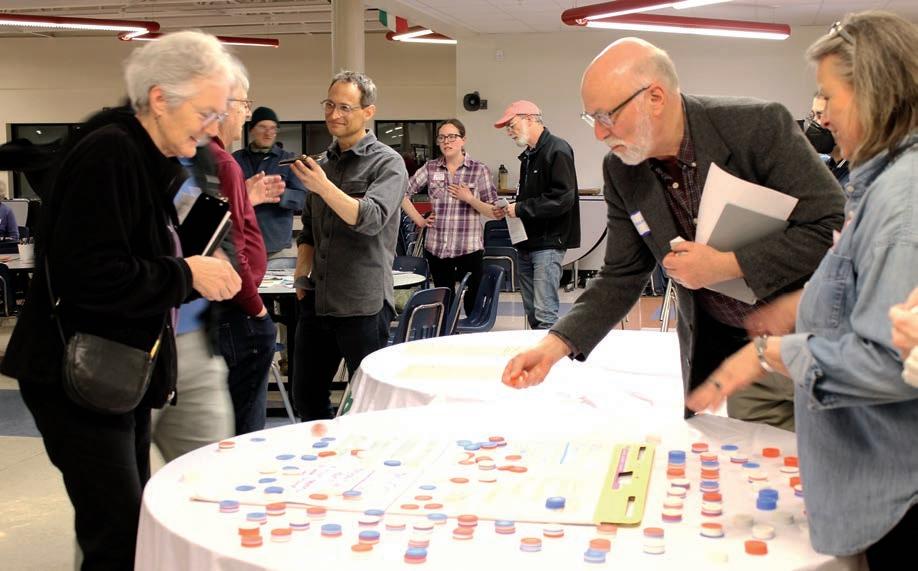
BRIANA BRADY STAFF WRITER
As attendees at a recent input session on Vermont’s new climate action plan used their phones to answer a live survey about their personal experiences with climate change, the growing number of words populating the screen at the front of the room reflected the anxieties of a group whose lives have already been altered, in big and small ways, by a changing climate.
David Plumb, a mediator working with the Vermont Climate Council on the rewrite of the state’s climate action plan, read some of the submissions from the crowd aloud.
“It’s about the flooding. It used to snow more. I’m feeling concerned about my grandchildren. Earlier tapping for maple sugar ing. It’s really frustrating in terms of budgeting for our communi ties. We’ve been seeing drought. Summers are too hot,” Plumb read.
The meeting, which was held April 15 in the Champlain Valley Union High School cafeteria and attracted around 90 attendees, was the second of seven in-per son sessions the climate council is holding before the end of the month. The council is collecting feedback on the current draft of the plan, which will be adopted on July 1 of this year.
The first climate action plan was enacted in 2021 following the Global Warming Solutions Act, which legally required the state to reduce greenhouse gas emissions by 40 percent of 1990 levels by
2030. The Vermont Climate Council, which oversees the formation of a new action plan every four years, is made up of 23 people purposely appointed to represent different sectors such as farming, the energy industry or scientific research.
The drafted plan, as it stands now, is broad. Meeting attendees were asked to review 56 different priority actions that the council is considering for the 2025 update. Those priorities fall into a range of categories including transportation, building, workforce development, planning, and climate-resilient land.
the director of the state’s Climate Action Office, 40 percent of emissions in Vermont come from transportation. This is followed closely by the amount from heating homes and commercial buildings, making climate solutions around those issues a focus of the council.
Lazorchak also noted that some of the solutions were focused on funding. Last year, she said, 80 percent of the $350 million earmarked in the state budget for cutting climate pollution came from federal funds. With the Trump
















Total reported incidents: 483
Arrests: 19
911 hangups: 7
Crashes: 29
Alarms: 24
Agency assists: 22
Public assists: 23
Directed patrols: 32
Disturbance: 15
Domestic incidents: 8
Foot patrol: 33
Found/lost property: 8
Fraud: 5
Juvenile problems: 10
Larceny: 18
Mental health incidents: 6
Motor vehicle complaints: 14
Retail theft: 21
Stolen vehicle: 3
Suicidal person: 4
Suspicious events: 28
Threats: 8
Traffic stops: 16
Trespass: 22
Unlawful mischief: 7
Welfare check: 27
Arrests/citations:
Robert W. Sears, 47, of Barre City, for burglary on Shelburne Road, following a March 6 incident.
April 14 at 2:20 a.m., Michael J. Maynard, 24, no address listed, for unlawful trespass on Shelburne Road.
April 14 at 8:16 a.m., Nicholas J. Hulbert, 36, of Burlington, for retail theft on Williston Road.
April 15 at 8:24 a.m., Amber-Lee M. Clark, 29, no address listed,
South Burlington Police Blotter: April 14-27
on an in-state warrant on Victory Drive.
April 15 at 8:58 a.m., Donald R. Fickett, 44, no address listed, on an in-state warrant on Dorset Street.
April 15 at 11:10 a.m., Tad M. Bennett, 56, of Williston, for unlawful trespass and disorderly conduct on Williston Road.
April 17 at 7:54 p.m., Andrew W. Scott, 57, of Milton, for domes-
continued from page 3
administration cutting federal funding across the board, it is unlikely that the state will be able to continue to rely on federal money.
“We knew this day was coming, to think about the responsibility of how we fund that long term, but it’s coming somewhat faster than I think any of us could have understood or expected, and so some of the solutions you’ll see tonight as recommendations contemplate new ways to raise revenue,” she said.
Plumb acknowledged that each person might not be able to thoroughly read through all 56 priorities, but asked participants to take note of what they liked and what they didn’t.
“Question number one, what’s compelling here, what’s most important here? Question number
South Burlington’s Community Newspaper Since 1977 A publication of Vermont Community Newspaper Group LLC otherpapersbvt.com
Advertising Director Judy Kearns judy@otherpapersbvt.com (802) 734-2928
tic assault on Dorset Street.
April 17 at 11:14 p.m., Tyrone P. Burris, 60, of South Burlington, for domestic assault and unlawful mischief on Farrell Street.
April 18 at 9:45 a.m., Samuel J. Olds, 37, no address listed, for grand larceny on Shelburne Road.
April 18 at 6:56 p.m., Hailey M. Rheaume-Fox, 28, of Williston, on an in-state warrant Shelburne
and Queen City Park roads.
April 18 at 8:07 p.m., Leonardo Carranza Vaquiz, 23, of South Burlington for driving under the influence on Suburban Square.
April 20 at 2:46 p.m., Michael J. Maynard, 24, no address listed, on an in-state warrant on Shelburne Road.
April 23 at 10:22 a.m., Lacey Jean Norton, 29, no address listed, on an in-state warrant on Shel-
burne Road.
April 23 at 11:34 p.m., Tyrone P. Burris, 60, of South Burlington, for resisting arrest and violating conditions of release, on Farrell Street.
April 24 at 10:29 p.m., a 19-yearold juvenile, no address listed, for driving under the influence,
See BLOTTER on page 20
two is, what is the urgent feedback you have for the council right now?” Plumb said.
In the plenary discussion, the concerns from different attendees often mirrored their experiences.
“Over the last year, last two years, on July 10, we’ve had two 100-year floods, and we’re anticipating another one this year. It seems to come up right after July 4. So, we don’t have time to waste. We need to do stuff that’s big,” one attendee from Richmond said.
Those floods in Richmond and in Hinesburg, as well as the flooding in central Vermont two years ago, were declared disasters by the Federal Emergency Management Agency. For the early July flooding last year alone, the agency provided more than $11 million in individual assistance to help aid in repairs.
The Town of Hinesburg, which saw culverts washed out and roads
destroyed, is still in the process of securing FEMA funding for repair work.
Other concerns came out of work and professional experience.
“I didn’t see anything in regard to protecting outdoor workers. It may seem like a sort of a side thing, but we have a lot of outdoor workers in Vermont. I’ve been that myself, many times. I have a particular sense of what it’s like, and it’s construction workers, rec department workers, road workers, it’s farm workers, it’s kids having fun,” Steve Crowley of South Burlington, said, raising concerns about workers well-being in rising heat. Crowley is director of the Vermont Community Solar Association.
More comments focused on land conservation, home weatherization, and building regulations as towns work to build more housing to meet new targets. One of the big takeaways, however, was
interest in cap and invest programs, which would require businesses to purchase allowances when emitting greenhouse gases beyond a set cap.
As presented in the draft, after preparatory studies, the cap and invest program would first focus on the transportation fuel sector. The funds raised through allowances might help close the gap created by any pullback in federal funding. Whatever final form the draft ends up taking, Beth Sacks of Burlington asked that the state government take the plan seriously.
“I think the first thing we need to do is honor the plan,” she said. “We need to recognize it’s not aspirations. We need to follow it, and we need to make sure that the measures add up to the goals that we set. I also think we have to get serious about mandates and having government play the role that it needs to play.”
General Manager Katerina Werth katerina@stowereporter.com
Advertising Wendy Ewing wendy@shelburnenews.com (802) 238-4980
Editor Tommy Gardner tommy@stowereporter.com (802) 253-2101 x25
Staff Writers
Aaron Calvin Liberty Darr Patrick Bilow Briana Brady
Production/Design
Stephanie Manning stephanie@shelburnenews.com Kristen Braley kristen@stowereporter.com
Billing inquiries Leslie Lafountain leslie@stowereporter.com (802) 253-2101
Advertising submission deadline: Friday at 5 p.m. advertising@otherpapersbvt.com classifieds@otherpapersbvt.com
Editorial submission deadline: Friday at 12 p.m. news@otherpapersbvt.com
Calendar submission deadline: Friday at 12 p.m. news@otherpapersbvt.com
Contact: PO Box 489 Stowe, VT 05672 (802) 253-2101
Enjoy a heartwarming Mother’s Day brunch featuring live music, fresh flavors, and cherished moments with the ones who matter most in our beautiful atrium.

SUNDAY, MAY 11
TWO SEATINGS ( 10:30-11:00 AM & 1:30-2:00 PM ) ADULTS $65 | AGES 5-12 $28 | UNDER 5 FREE Prices do not include taxes and gratuity.
• Made-To-Order Omelets with Fresh Ingredients

Guest Perspective
Beth Zigmund
On April 7, I coaxed myself over to City Hall for a “visioning event” that aimed to gather public input on South Burlington’s Open Space Master Plan: the future of our open space, parks and recreation. The event was well-attended, and the positive sense of community and collaboration was uplifting and reassuring, particularly given the national mood.
As our country and much of the world tilts dangerously toward authoritarianism, we also confront the interlocked dilemmas of nature loss, climate change and pollution, planetary diseases caused by the unrestrained extraction and consumption of resources. I’m grateful that our city is asking us, and has appointed a climate action manager, to weigh in on these important decisions, measures that will help determine how well we meet a much different future world than the one we’re used to. Even if we only consider climate change, we have our work cut out for us. Vermont is the sixth most rapidly warming state in the country, according to ClimateCentral.org, and sixth on the list for FEMA and the U.S. Department of Housing and Urban Development funding as a share of total state spending, according to the Carnegie Endowment for International Peace.
limited resources? How will we manage the inevitable consequences of our increasing population – air pollution, noise pollution, greater demands on local infrastructure in an age of increasingly destructive weather?
One group that seemed underrepresented at the event was families with young children, as is often the case, given their myriad after-hours duties. So, I pose a question on their behalf, which is among the most important of all in my view. In the choices we make now, how can we protect the interests of children and future generations who will inherit the worst consequences of problems they have done little or nothing to cause?
Our city needs more affordable housing. As we build, will we require developers to include green spaces and parks?
Thankfully, the recent event suggested we people of South Burlington have considered many of these questions and aren’t blind to what’s occurring or what lies ahead. Responses to the city’s proposals revealed deep values around safeguarding and respecting nature, with strong support for protection of ecosystem services (e.g., carbon sequestration, air quality), preservation of wildlife habitat and water quality and preservation, as well as opportunities for passive recreation (e.g., walking, nature study) and well-maintained trails and paths for outdoor recreation and active transport.

Mother’s Day!
Hanging Baskets
Rose Bushes
Perennials & Annuals
Vegetables & Herbs
Shrubs & Trees
Topsoil & Compost
Mulch & Seeds
Gift Certificates


We’d be foolish to believe future impacts will spare our city. South Burlington faces hard questions, many of which were on display at the recent event. What will we do with what little precious, undeveloped land remains in our city, and how will our choices help or hurt when natural disasters strike?
Our city needs more affordable housing. As we build, will we require developers to include green spaces and parks? As we pour more concrete, will we require tree protection and planting to provide vital cover and cooling in an era of escalating heat threats, particularly in lower-income neighborhoods?
Is there land closer to the city center that can be conserved for passive recreation to more equitably distribute our
More public input sessions to inform the city’s Open Space Master Plan are coming up. Please join in and encourage your friends and neighbors to do so as well. Events like these promote open communication, community involvement, connectedness, and preparedness — our best hopes for confronting the 21st century.
We will also need to encourage and support clear-minded local leaders who are willing to do the arduous, often emotionally taxing work of educating themselves about the range of potential trajectories for our disrupted natural world and climate, so they might make the best decisions not only for South Burlington today, but for the future.
Beth Zigmund lives in South Burlington.



Guest Perspective
Jack Hoffman
Now that the House has passed an education reform plan, it will be easy to get bogged down in the minutiae that differentiate it from Gov. Phil Scott’s “Education Transformation Proposal.” But before Vermonters get lost in the weeds debating these proposals, they might want to ask themselves if they support the radical change that both plans represent:
• Are they ready to abandon the idea that taxation for public education should be based on residents’ ability to pay and that a person’s income is the fairest measure of that ability?
to a property-based school tax system, locking in this break for wealthy homeowners.
The administration and House each propose some form of “homestead exemption.” The exemptions would be tied to household income and exclude a portion of home value from taxes. But adjusting house values according to the owner’s income bracket is not the same as taxing income.
The biggest flaw is that the wealthiest Vermonters are taxed on their home value, not their income.
• Are they ready to take control of education spending away from local voters and cede it to the Agency of Education?
For more than 25 years, the funding system has recognized that taxing people according to ability to pay was the fairest way to share the cost of educating our children. And a homeowner’s income, rather than the current selling price of the house, has been viewed as a more accurate measure of a person’s ability to pay taxes.
Under the current system, about two-thirds of resident homeowners pay some or all their school taxes based on their income. There are problems with the current system, despite efforts to go to a simple income-based school tax for all residents. But the biggest flaw is that the wealthiest Vermonters are taxed on their home value, not their income.
That means the wealthy pay less of their income to support education than do typical homeowners making $80,000 or $90,000 a year. The wealthiest 30 percent of homeowners get about 60 percent of Vermont’s adjusted gross income, but don’t pay school taxes based on that income.
Instead of addressing this imbalance, both the administration and the House want to revert
The market value of the house, not the homeowner’s income, would ultimately determine the tax.
Homeowners on fixed incomes would once again be vulnerable to changing real estate prices. And homeowners with the same income but different house values, in districts with the same per-pupil funding, would not pay the same taxes, as they do now.
The governor and Legislature complain that Vermont spends too much on education for the results it gets, although some districts are criticized for not spending enough. The feeling is that local voters don’t make sound spending decisions, even though they are voting on their own taxes and how to spend the state’s (i.e. their own) money.
Recent reforms were supposed to save money and improve student performance: school consolidation, a new special education funding formula, a new weighting system to direct funding to certain students. But when education spending jumped this year — because of Covid, inflation, healthcare and mistakes in implementing the new weights — it provided Montpelier an opportunity to change the funding system and take away local voters’ control.

may further alienate voters and discourage democratic participation.
The governor and House each proposed foundation-type funding systems. Essentially, a per-student “foundation amount” would be allocated to all students. The foundation grants may be supplemented for students needing additional funding.
The Legislature and the governor want further consolidation despite the failure of Act 46, the first consolidation law, to achieve promised results. The governor proposed five mega-districts. While that was too few for the House, 20 might be enough. But large districts, coupled with the new approach to funding,
But whether it’s the governor’s model or the Legislature’s, we can expect the actual calculation of the foundation amount and ancillary adjustments to be generated at the Agency of Education by a consultant-designed computer program, not unlike the database and program used to generate Vermont’s new
pupil weighting system a couple of years ago.
A single, base amount of funding that works across the state seems to fly in the face of what we learned about cost increases districts incurred this year. Staffing shortages and demand for mental health services, for example, hit some budgets harder than others. How would a foundation amount allow for that kind of variability or the preferences of Vermont’s diverse communities?
The governor and Legislature are pressing ahead with a new tax and funding system long before the Commission on the Future of Public Education in Vermont has completed its work or even heard from people across the state. They are pressing ahead without fixing the unfairness of the current system that favors wealthy homeowners. And they are pressing ahead even though a foundation formula, while it may reduce funding to schools, doesn’t reduce the costs that drove up education spending this year.
If the past decade of reforms taught us anything, it’s that these big changes don’t always live up to their promises and come with unintended, often negative, consequences.
Jack Hoffman is Senior Analyst at Public Assets Institute (publicassets.org), a non-partisan, non-profit organization based in Montpelier.
Miro Weinberger
If you’ve turned on a podcast, watched a late-night show, or scrolled social media in the past month, you’ve probably heard something about “Abundance,” the new book by Ezra Klein and Derek Thompson. The thesis is simple yet powerful: America, especially in blue states, has over decades created systems that prioritize stopping things rather than building them. We’ve become experts at saying no.
“Abundance” has struck a nerve — for good reason. It is a call to action, a challenge to break free from what the authors describe as “the politics of blocking.” It’s about a country that’s forgotten how to build: homes, transit, clean energy the infrastructure of opportunity.
Sometimes Vermont can seem insulated and removed from national political conversations, and it can be easy to think some of these discussions don’t apply here. We pride ourselves on being a little different, a little apart.
But this one? This conversation is 100 percent about us.
When Klein says we’ve built a political system that’s better at stopping things than getting them done, he could be talking about Vermont’s housing shortage. We’ve created a system that makes it incredibly hard to build the homes we need. Our state faces a critical housing shortage, yet the pathways to create more homes are gauntlets of redundant state and local rules, costly government mandates and a permit appeals systems that enables obstructionists.
As a result, the average Vermonter
experiences soaring rents, impossible home prices and a growing number of neighbors without secure housing.
We started Let’s Build Homes to ensure this isn’t Vermont’s future. We are working to transform our state from one that excels at blocking to one that prioritizes building in the right places, and we are already having an impact.
In this legislative session, we’ve supported a bill that will make it easier to finance and build the infrastructure — like water, sewer and roads — that makes new housing possible. Thanks in part to our testimony and the coalition members who contacted their legislators, this bill has now passed the Senate. We are also working directly with municipalities to modernize zoning and allow more housing in the places where it’s most needed.
Next, by engaging the process launched by the Legislature a year ago, we’re taking on one of the biggest barriers: reforming the outdated maps and rules under Act 250 that limit where and how we can grow.
This isn’t going to be easy. Already, we can see new groups forming that want to continue the politics of blocking. We must push ourselves to grow in a way that respects our cherished natural landscape and is better than the development we have seen in other parts of the country. Vermont’s future depends on finding this balance.
But make no mistake: If we are going to end homelessness, be a state where young families can get a start, provide all our kids a good education, enjoy high quality health care throughout the state — if we want a future of abundance, not scarcity — we are going to have to grow. The alternative is a Vermont that
becomes increasingly unaffordable, where only the wealthy or those receiving aid can live, where our schools continue to empty, where our rural communities are hollowed out, where our workforce shortage worsens and where more Vermonters find themselves without homes. That’s not the Vermont any of us want.
The politics of abundance requires courage. It means standing up to voices that reflexively say no. It means embracing change while being thoughtful about how we manage it. It means creating new systems for government decisions and action that prioritize results and speed
over undue process.
Let’s Build Homes is committed to leading this transition from a state of blocking to a state of building. Join us in creating a Vermont where everyone can find a place to call home. Join the coalition at letsbuildhomes.org.
Miro Weinberger was the Mayor of Burlington from 2012 to 2024. He is currently serving as the executive chair of Let’s Build Homes and as a Visiting Fellow at the Harvard Kennedy School of Government Taubman Center for State and Local Government.





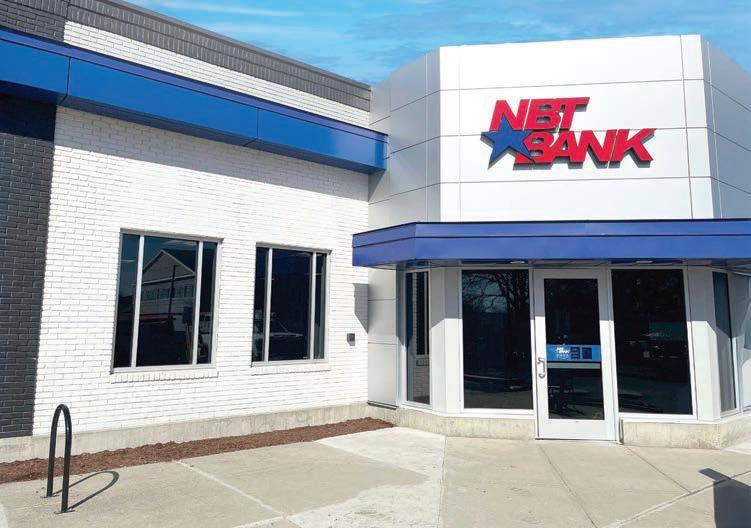
Let us show you how we go the extra mile to be your top choice for banking: Stop by our new location. 1330 Shelburne Road | South Burlington, VT 05403
• 24/7 Account Balance and Transaction Monitoring
• Send Money to Friends and Family with Zelle®
• Convenient Mobile Check Deposits
• Enhanced Fraud Protection and Text/SMS alerts
• User-friendly Online Bill and Loan Payments
• Enroll in Direct Deposit to Automatically Deposit Paycheck
We can’t wait to meet you.
Jenna Boiney Senior Relationship Banker
802.341.8848
Jenna.Boiney@nbtbank.com
Chris Walker Branch Manager
802.341.8848
Chris.Walker@nbtbank.com
Chris Cannata Senior Relationship Banker 802.341.8848 Christopher.Cannata@nbtbank.com
Open an account online or visit your local NBT branch today. It only takes minutes to start banking better.
When we support parents, we support families
To the Editor:
As you may be aware, May marks Maternal Mental Health Month, an important time to bring awareness to a topic that often goes unspoken: the emotional well-being of parents during pregnancy and the first year after childbirth. While bringing a child into the world is often portrayed as a joyful time, for many, it is also may be a period filled with stress, anxiety and depression.
Perinatal mental health conditions — including postpartum depression, anxiety, OCD and psychosis — affect 1 in 5 mothers and parents, and often includes partners and fathers. These are not signs of weakness or failure; they are common, treatable medical conditions that deserve the same attention and support as any physical health issue.
Unfortunately, stigma and lack of knowledge of resources can often prevent people from seeking help. That’s why it’s crucial for our community, health systems and policymakers to prioritize mental health screening, support and education for all expecting and new parents.
During this Perinatal Mental Health Month, please help us, the Postpartum Society International, Vermont Chapter, commit to showing compassion, listening without judgment and advocating for better care of parents in the postpartum period. When we support parents, we support families — and healthy families build stronger communities.
Alison Legrand Hrindo
South Burlington
Alison Legrand Hrindo is on the Postpartum Society International Vermont Chapter’s board of directors.
To the Editor:
I would like to offer a different perspective on the issue of housing growth that was raised in a recent letter to the editor (“Benefits for some, costs for many,” April 17, 2025). Responsible growth in South Burlington benefits both new and existing residents by providing housing opportunities close to employment, family and local amenities, thereby enhancing the overall quality of life.
The assertion that increased housing directly results in higher property taxes is an oversimplification presented without
clear evidence. In reality, there are multiple factors influencing property taxes.
For instance, the primary drivers of tax increases over the past two decades include rising per-pupil education costs related to the flawed state funding formula and health care costs, as well as expansions in city services and infrastructure. Worthwhile community improvements such as the construction of our new city hall and library were partly funded by new development in the city center.
Regarding the claim about “huge environmental and social costs to housing,” it is important to understand that responsible development can balance environmental impacts through sustainable building practices, efficient land use and thoughtful urban planning that prioritizes in-fill development, while conserving agricultural lands, wetlands and wildlife habitat areas.
South Burlington is actively pursuing these responsible practices. Conversely, insufficient housing leads to increased homelessness, higher rents and significant social costs. Surely, providing adequate housing is far preferable to forcing people into less stable living conditions, such as temporary shelters or tents.
As Vermont’s second-largest city, South Burlington offers residents significant benefits due to proximity to essential services such as our international airport, healthcare facilities, auto dealerships, diverse restaurants, retail shopping options and exceptional access to quality supermarkets. These amenities enhance convenience and enrich our community’s overall quality of life.
Residents living in newly developed housing often express appreciation for being close to workplaces, families and social networks. Local access to health care, goods and services requires workers who, in turn, need stable housing. Responsible growth not only addresses housing needs but also strengthens our local economy and supports a vibrant, accessible community.
In summary, thoughtfully managed growth in South Burlington that carefully considers environmental impacts creates benefits for all residents by expanding housing choices, improving accessibility to essential services and fostering community vitality. While growth and change bring challenges, recognizing the numerous advantages is crucial for our city’s continued success.
Steve Comeau South Burlington



Guest Perspective
Liz Spitler
Depending on when you were born, you may remember watching Popeye promoting the consumption of spinach. Popeye instantly gained superhuman strength after eating spinach and made the leafy green vegetable seem powerful and desirable to children.
This led to a reported increase in spinach consumption among kids during the height of his popularity. The message was clear: eating your vegetables makes you strong. Even better, it spoke the truth. Whatever happened to these sage superheroes?
Full physical and mental development of children depends on intentionally nourishing their bodies with foods that have shown to improve functionality and mood, underscoring the critical difference between simply eating and actively nourishing.
Young children are largely dependent on their caregivers for the food choices available to them. They lack autonomy and often the knowledge to make informed decisions about their diet. Therefore, the nutritional environment created by adults directly affects their intake.
Lifetime habits begin at birth. It’s during early childhood that critical aspects of children’s social skills, peer relationships and a growing sense of independence and self-identity is developed.
Children spend more time outside of the family and navigate school and extracurricular activities. Children are wide open to outside influences, with varied
positive and negative results.
Influences like fast food and ultra-processed foods are hard to keep a secret. The fast-food industry’s extensive research and development into flavor profiles and food science likely includes a deep understanding of how certain combinations of ingredients, such as high levels of fat, sugar and salt, can create highly palatable and craveable food products that encourage frequent consumption. These are enticing to kids, but with detrimental results to their growth and development.
Kids see 5,000 to 10,000 food ads per year, most of them for junk food and fast food. Hundreds of billions of dollars are spent today in the fast-food industry to capture your child’s attention. With messages like “You Rule” or “I’m lovin’ it,” where is Popeye when we really need him?
The nutritional needs of school-aged children are challenged due to environmental and socioeconomic factors. While food availability and security play a vital role, children’s food choices are shaped by this target marketing, as well as their home, community and school environments.
Food can significantly impact our children’s long-term health and their performance in school and activities. Along with the potential for impaired cognitive development, studies have shown, lower educational attainment, as well as reduced future earning potential. Therefore, addressing nutritional deficiencies in schoolaged children early is crucial for both immediate physical health and their long-term cognitive, social, and emotional well-being.
In the mid to late 1990’s, new programs focused on linking schools with nearby farmers to supply fresh fruits and vegetables for lunches and educated students about healthy eating, and regenerative agriculture. Vermont, with its inherent connection to the land, naturally reawakened its rich agricultural heritage in support of farm to school. Vermont used to have approximately 29,000 farms one hundred years ago. Today, Vermont has around 6,500 farms.
While securing funds for farm to school programs has always been an uphill battle, the latest news represents a significant setback.
Earlier this year, the USDA entered into a cooperative agreement with the Vermont Agency of Agriculture, Food, and Markets for $1.22 million in funding for Vermont. As federal funding for farm to school programs was being planned and implemented on March 7, the USDA abruptly announced the termination of the program. This has sent shockwaves through the farm to school community.
How do we protect and sustain our children’s food systems for today and tomorrow?
Just like Popeye’s consistent spinach consumption, children need early and repeated exposure to a variety of fresh, whole foods. This helps develop taste preferences and normalizes healthy eating. Let’s work together and advocate for reliable and increased local funding for farm to school initiatives.
Liz Spitler handles communications for Common Roots farm in South Burlington.
The coup happened quickly, will last as long as the people allow it
Guest Perspective
John Bossange
It happened so quickly. Yet, here we are with an elected U.S. president who appears to have complete control of all three branches of our government. That concentration of power has occurred in the past. However, unlike all those presidents who served before him, the Supreme Court has granted President Trump immunity from criminal prosecution when issuing “official acts” while in office.
That’s a massive change to the functioning of our branches of government, setting up a constitutional crisis in America.
This one Supreme Court decision, written by Chief Justice John Roberts explaining the Court’s decision in “Trump vs. the United States,” has placed President Trump above the law and beyond the historically understood limited power of the executive branch. Any president can now operate as a dictator, or as the Heritage Foundation’s Project 2025 playbook calls it, a “Unitary Executive.”
Let’s Make You a Neighbor! YOUR NEXT MOVE STARTS HERE

Raising a family in South Burlington for the past 30 years has been a blessing. I’d love to help you nd your next home here too, not just as your agent, but as your future neighbor! Whether you’re looking to buy or sell, The Marcelino Team gets the job done! I’m your hometown girl with the key to get your real estate journey started.
Amy Deavitt

802-238-9743 • amy@themarcelinoteam.com www.TheMarcelinoTeam.com

No law-abiding U.S. citizen from any political party or from any corner of America should be celebrating this misguided, consequential landmark decision. Patriotic Americans believe in the separation of powers as defined by the U.S. Constitution. That’s gone now. The immunity decision gives President Trump the power to make “official acts” without consulting or getting the approval of Congress. Further, as President Trump has done for
















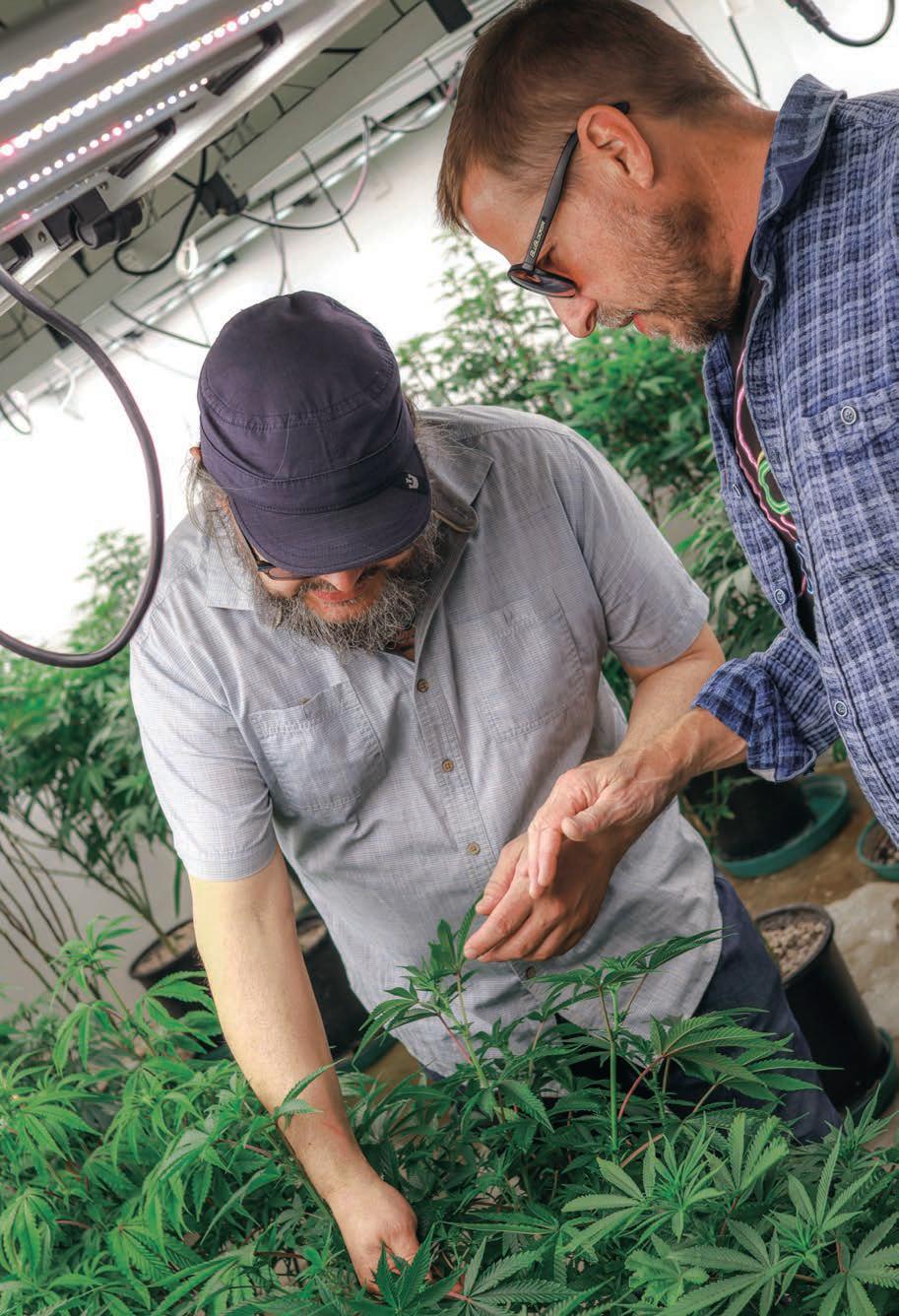
PATRICK BILOW STAFF WRITER
Cannabis and craft beer is a feel-good combination in more ways than one.
The Alchemist, a brewery in Stowe known for Heady Topper and other double IPAS, has started donating captured carbon dioxide from its facilities to Vermont Medicine Man Craft Cannabis in Marshfield, and it seems to be the special ingredient for producing big, dense nugs.
“It’s kind of a perfect fit,” John
Kimmich, who owns The Alchemist with his wife Jen, said. “The carbon that our beer produces is literally a physical building block of [Medicine Man’s] cannabis flower.”
Carbon dioxide is created alongside alcohol during the fermentation process, and while some breweries might just release that gas into the atmosphere, The Alchemist has been capturing its own for years.
The brewery uses a special machine made in Texas, allowing it to capture and recycle CO2 back
into its production process for carbonating beer and cleaning out containers. But they can’t reuse all of it.
Luckily, cannabis plants love CO2. In fact, it’s a key component of nearly all industrial indoor grow operations and it boosts plant metabolism, accelerating their growth and producing denser flowers, according to Justin Kuehnel, the cultivator at Medicine Man.


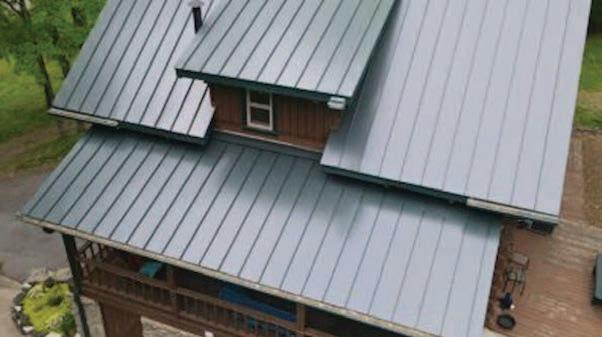


DEBORAH J. BENOIT
Have you ever heard of the lady in the bath flower? That’s just one of the common names for bleeding hearts (Lamprocapnos spectabilis, formerly Dicentra spectabilis). If you’re wondering where that name comes from, just look at the flower upside down and you’ll see her.
Other common names include heart flower, lyre flower or Asian bleeding heart. There is a bleeding heart (Dicentra eximia) native to the eastern United States that’s commonly referred to as the fringed bleeding heart. It has grayish-green colored foliage and pink to purple-red flowers and, at about 18 inches in height, is somewhat smaller than Lamprocapnos spectabilis.
Interestingly, while Dicentra spectabilis appears related to our native bleeding heart, genetic testing revealed it is not. This led to it being reclassified as Lamprocapnos spectabilis, many cultivars
of which are available to home gardeners.
Bleeding hearts are one of the fleeting pleasures of spring in the garden. Each year, this perennial emerges from the ground, its stems reaching upward and outward. Heart-shaped flowers in combinations of red, white or pink dangle beneath the arching stems.
Native to Asia, Lamprocapnos spectabilis was introduced to European gardens in the mid-1800s and has been a shade garden favorite since that time. It is a charming, old-fashioned flower equally at home in a cottage garden with dappled sunlight or in a woodland shade garden.
Bleeding hearts are hardy in United States Department of Agriculture Plant Hardiness Zones 3-9. They grow 2-3 feet tall and wide and bloom for 4-6 weeks each spring. The flowers attract bees, butterflies and hummingbirds and offer a mild, sweet fragrance.
If you enjoy sharing plants or simply want more of a good thing for your own garden, mature plants
can be dug up when dormant and the root clumps divided using a clean shovel or blade. Plant in early spring as soon as you can work in the soil. You can also plant during the fall when temperatures are mild to give the roots a chance to establish before the ground freezes. Either way, you may want to mark the planting location to avoid accidentally digging up the roots during its dormant period.
For best results, plant in partial shade or filtered sunlight in rich soil that drains well. Amend soil with compost if needed. Heavy soil that retains water may cause root rot.
Add a layer of mulch to help keep moisture levels consistent. Mulch will also help keep soil cooler during the heat of summer and protect the roots from freezing and thawing in winter.
Feed, if needed, in early spring — according to package directions — to encourage flower and root




ANDREA KNEPPER UVM EXTENSION
There’s no need to guess what your garden needs for optimal results. Take a soil test this spring to create the right conditions for your garden from the start.
A simple soil test will help prevent problems later in the season. By following the recommendations in your results, you can give your plants a strong start, leading to better growth, bigger blooms and a more rewarding harvest.
A soil test provides a complete picture of what’s going on beneath the surface in your garden. You will get information on the pH of your soil, how much organic matter is present and the levels of phosphorus, potassium, magnesium and
other macronutrients and micronutrients.
Nitrogen is not included in soil tests because its availability in the soil fluctuates due to biological activity and weather conditions. With the test result information, you can make informed decisions about what to add to your garden soil before you plant.
The University of Vermont Agricultural and Environmental Testing Lab conducts soil testing for home gardeners and commercial farmers. Visit its website at go.uvm.edu/soiltest for the submission form and additional information. The cost for a basic nutrient soil test is $17 per sample.
To begin collecting your soil sample, you will need to have a clean trowel or small shovel, a
clean bucket and a plastic bag. The bag needs to be able to hold 1/2 a cup to 1 cup of soil. It is important that all materials are clean to avoid contamination.
Choose the area you want to sample. If your garden beds have different purposes, collect a sample for each space you want to test. For example, if you have one bed for annual flowers and another for garden vegetables, you may want to sample these separately as they have different nutritional needs.
In the chosen area, identify about 10 different spots to collect soil. These should be distributed throughout the space. Dig a small hole about 6-8 inches deep — the root zone for most plants. Then, take a slice of soil along the side

of the hole. Put this sample in your bucket.
Repeat this process at each location. The more locations you take samples from, the better your results will represent the average conditions of your garden.
in two to three weeks by email or mail, according to your preference.


Thoroughly mix the samples in your bucket. Then, scoop ½ cup to 1 cup of soil and place it in your plastic bag. Label the bags, especially if you are submitting multiple samples. Your soil is now ready to send to the lab for testing. Include the completed soil test submission form and mail your sample to the UVM Agricultural and Environmental Testing Lab for analysis. You’ll receive your results





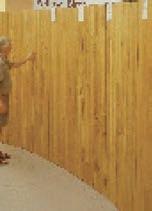
Your results will include information on the current state of your garden soil and offer recommendations for amendments to maximize the quality of your soil for gardening as well as includes resources to help you interpret the results of your soil test.
The UVM Extension Master Gardener Helpline also can help you make sense of garden and lawn soil test results. Complete the form on the website, go.uvm.edu/ gardenhelpline, upload a copy of





Michael J. Caduto
Fractals are sometimes referred to as a “visual representation of math.”
They can be observed in the spatial arrangements found in many familiar forms, patterns, and shapes in nature: from the branching of trees, ferns, river systems and lightning, to the patterns found in leaves, seedheads, crystals, seashells, snowflakes, clouds, hurricane, and geologic terrain. The intricate branching patterns of blood vessels
BLEEDING HEARTS
continued from page 11
development. After it’s finished flowering, the foliage will yellow and die back. The plant will go dormant until the following spring.
Bleeding hearts spread by underground stems called rhizomes or through self-seeding. They’re not considered aggressive in the garden. They are a low-maintenance plant, but root rot may occur due to standing water or excessive moisture in heavy soil. They’re also a good option if deer or rabbits tend to browse in your garden as both tend to avoid nibbling on them.
A word of caution: Although bleeding
and respiratory structures are some intimate expressions of fractals in animals.
As a fractal grows, the pattern replicates itself on a larger scale. The mathematical foundation for our understanding of fractal geometry was laid by the German mathematician, Felix Hausdorff, during his groundbreaking work modeling the mathematics behind geometrical shapes and patterns. In 1918, Hausdorff introduced the Hausdorff (fractional) dimension, a model that shows
See FERNS on page 14



hearts appear delicate and harmless, all parts of the plant are toxic to pets and humans if eaten. Touching them may cause skin irritation, so wear gloves as a precaution. If you have questions regarding bleeding hearts or other home-gardening questions, contact the University of Vermont Extension Master Gardener Helpline at go.uvm. edu/gardenquestion.
Deborah J. Benoit is a UVM Extension Master Gardener from North Adams, Mass., who is part of the Bennington County Chapter.








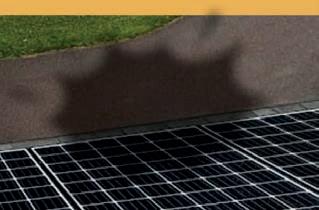













continued from page 13
how to calculate the dimensions of spatial patterns that replicate, or repeat, at different scales.
The word “fractal” was first used in 1975 by Benoît Mandelbrot, a French American mathematician who described intricate shapes and patterns that repeat even when an object is viewed at different levels of scale. Mandelbrot defined a fractal as “a rough or fragmented geometric shape that can be subdivided in parts, each of which is (at least approximately) a reduced-size copy of the whole.”
No matter whether you are looking at a fractal zoomed in or from a distance, each view resembles the same pattern.
Ferns are among the best and most accessible examples of fractals. The leaves of each fern, which are called fronds, form the selfsame pattern when viewed at any distance or scale.
In fact, one of the most wellknown formulas in fractal geometry is the Barnsley fern. In his 1988 book, “Fractals Everywhere,”
Michael Barnsley, a British mathematician, describes how he created this fractal to simulate the frond of black spleenwort (Asplenium adiantum-nigrum), a common European fern.
The fiddlehead pattern of a sprouting fern is a perfect example of a fractal. The familiar fiddlehead is a classic shape that — along with the similarly spiral-shaped nautilus — has inspired countless works of art and sculpture, from the carved
spirals at the tops of violins and other stringed instruments to the ingenious spiral staircases in the designs of the iconic Spanish architect Antonio Gaudi, and even to the spiral path at the start of the yellow brick road in “The Wizard of Oz.”
The spiral-shaped fiddlehead of a sprouting fern is formed by the petiole, or leaf stalk, as it unfurls into a frond. As the leaf stalk grows, each pinna, or leaflet, at first appears as its own minute fiddlehead. The next time you look at a lacey fern frond, try focusing in gradually closer and you will see how the overall pattern created by the entire frond is repeated in each of the gradually smaller elements that branch off of it.
Of course, not all ferns are intricate laceworks. Walking fern (Asplenium rhizophyllum), which is rare in most of the Northeast, has undivided fronds. Other fern fronds, including those of sensitive fern (Onoclea sensibilis), are simple divisions off of the main stem.
Fronds of the ethereal maidenhair spleenwort (Asplenium trichomanes) has individual pinnae branching off of each striking black stem. The fronds on some ferns, such as long beech fern (Phegopteris connectilis) are divided two times, while the most delicate ferns, including evergreen wood fern (Dryopteris intermedia), are divided three times.
Two of my favorite examples of how nature weaves the threads
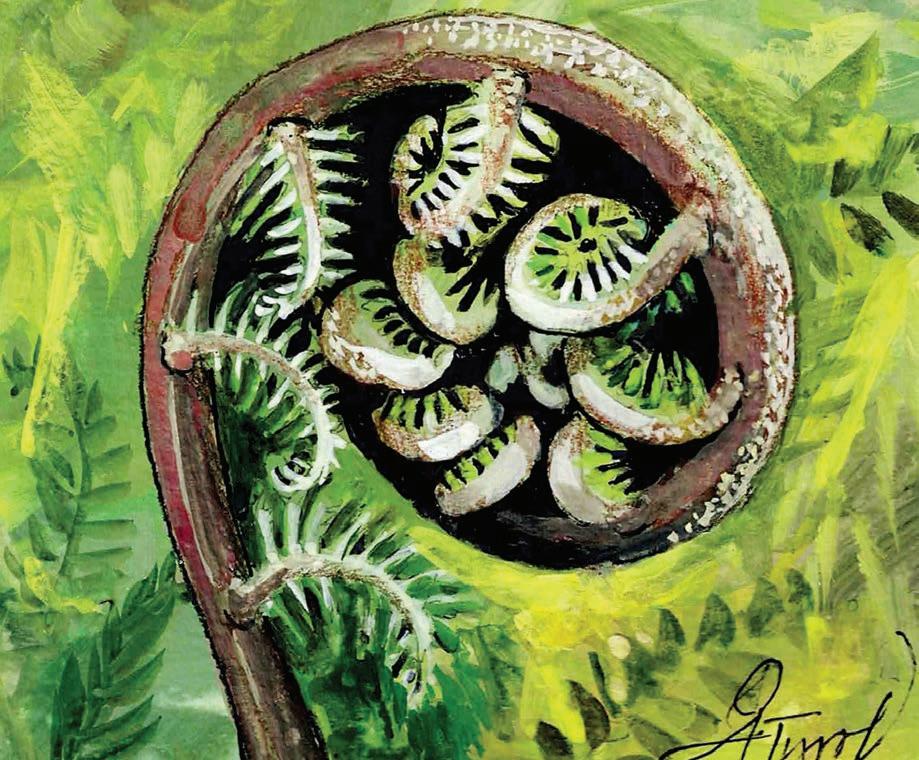
of geometry into beautiful green tapestries are the lacey arching fronds of northern maidenhair fern (Adiantum pedatum), which grows in moist, shady woodlands, and the tall, lush bushy masses of royal fern (Osmunda regalis) that commonly grows in and along wetlands. Both are found throughout New England.
The variety of shapes among ferns reveals that there are many examples of fractals found in the natural world. These are visually striking expressions of the hidden geometry that lends order to the fascinating forms that we see.
As the ferns begin unfurling this season, take a moment to contem-
plate their patterns and reflect on fractals.


Michael J. Caduto is a writer, ecologist, and storyteller who lives in Reading, Vt. He is author of “Through a Naturalist’s Eyes: Exploring the Nature of New England.” Illustration by Adelaide Murphy Tyrol. The Outside Story is assigned and edited by Northern Woodlands magazine and sponsored by the Wellborn Ecology Fund of New Hampshire Charitable Foundation: nhcf.org.
continued from page 12
your soil test results and an Extension Master Gardener will get back to you.
Starting your garden with a soil test can save you time, money and frustration. Instead of guessing what your garden needs, you’ll know exactly how to help your plants grow healthy and strong. It’s a small step that can make a big difference and it’s worth doing every few years.
Andrea Knepper is a UVM Extension Master Gardener from Bolton.
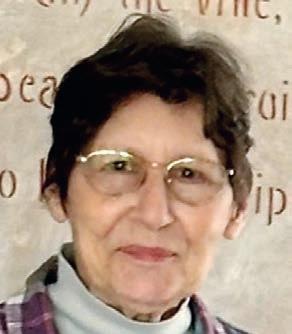
All Saints parish admin retires after 27 years
After 27 years of faithful service, Margaret MacLean retired from her professional role at All Saints Church, 1250 Spear St., South Burlington, on Sunday, April 27.
She was honored during the 10 a.m. Eucharist and a festive coffee hour, followed with a card shower, cake and refreshments. At MacLean’s request, any monetary gifts given in her honor were donated to JUMP (Joint Urban Ministry Project), which serves families and individuals throughout Chittenden County and northern Vermont.
Margaret and her husband, the Reverend Peter MacLean, moved to Vermont in 1997 after he retired as rector of St. Mary’s Episcopal Church, Shelter Island, N.Y.
They began worshipping at All Saints and Margaret was hired
as parish administrator in 1998. She brought with her a love of the Episcopal Church and a strong administrative background from working in New York City.
Looking back, MacLean shared these remembrances:
• “That was the beginning of a beautiful relationship with a congregation that I worked for and learned to love, respect and have fun with, and who loved and respected me.”
• “It was pretty simple in the early days without internet!”
• “When my husband died in 2021, I continued at All Saints, even though life was different; it was my touchstone.”
According to organizers, she has served God, seven Episcopal priests plus two deacons and hundreds of grateful parishioners, whom she says, “will be in my heart and DNA forever.”
Listen to sackbuts and other period instruments
The Champlain Consort performs medieval, Renaissance and Elizabethan music on period instruments May 6 at noon at Cathedral Church of Saint Paul, 2 Cherry Street, Burlington.
This program includes music from the 14th-16th centuries inspired by springtime, and performed on recorders, sackbut (Renaissance trombone), cornetto, capped reeds (crumhorns and more), voices and percus-
See COMMUNITY NOTES on page 18

160 Hinesburg Road, S. Burlington • 802-864-4166





Illuminate Vermont, held on April 25 and 26, 2025, transformed South Burlington’s Market Street into a vibrant celebration of local art, music, and community spirit. The free, family-friendly festival featured over 30 local vendors, food trucks, and live performances across multiple venues. Highlights included energetic sets by Ultra Violet and Jenni Johnson and the Jazz Junketeers, as well as captivating acts like Ryu’s Big Circus. The South Burlington Public Library hosted musical acts such as Laura Markowitz and Ukulele Clare & Rebecca, while the auditorium showcased documentary screenings by filmmaker Susan Bettmann and a ventriloquist performance by Al Getler.


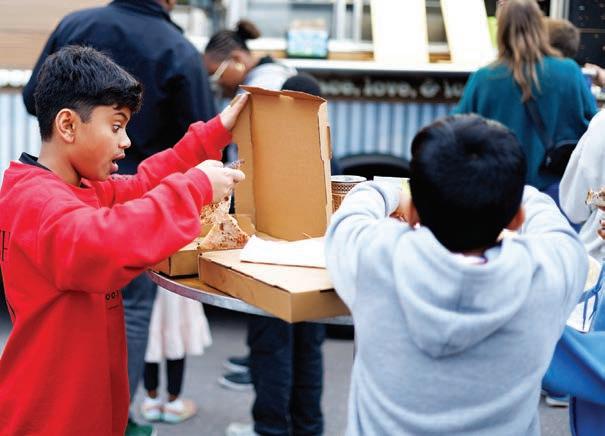





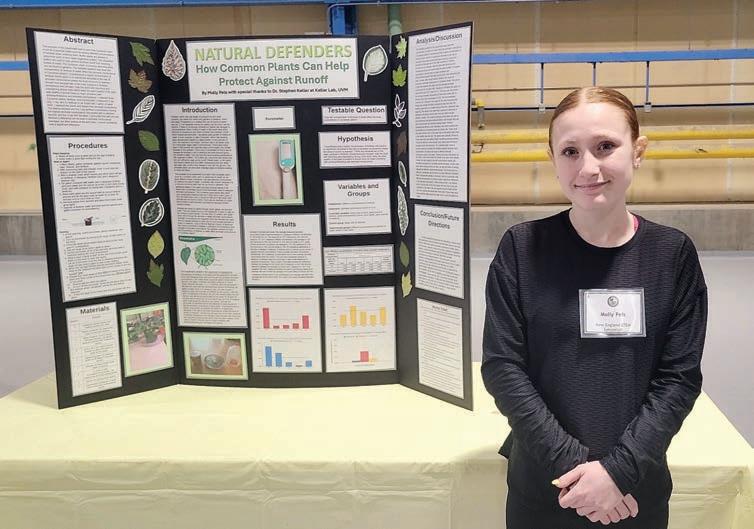

COMMUNITY NOTES
continued from page 15
sion. British, French, Italian and Spanish composers are featured, including Dufay, Byrd and Vasquez. This is a free concert, but contributions are accepted.
Councilor, educator talk civility, social contract
Burlington city counselor Gene Bergman and Fran Brock — inspector of elections and retired Burlington High School
history and civics teacher — will lead a discussion on civility and the social contract on Sunday, May 4 at 11:30 a.m.-12:30 p.m. at Barnes & Noble in South Burlington, 102 Dorset St.
Job fair matches vocation seekers with employers
The VermontJobs.com Spring Job Fair is Saturday, May 3, at the University Mall in South Burling-



ton from 11 a.m.-4 p.m. Admission is free.
The job fair provides access to employers from a wide variety of companies, nonprofit organizations and industries that are seeking committed and enthusiastic employees to fill hundreds of positions.
Attendees can speak directly with company representatives in the following job categories: professional, tech, manufacturing, healthcare, education, finance, municipal, nonprofits, construction, landscaping, retail, transportation, auto, clean energy, food and beverage, homecare and much more.
Trust has 10 pair available to borrow.
In celebration of Mother’s Day and Maternal Mental Health Month, join Fourth Family, Healthy Living, Empty Arms and This Mother’s Road for an afternoon of connection and community building, May 3 at 12:30 p.m. at the South Burlington Public Library, 180 Market St.
Better Future.”
Registration kicks off at 1 p.m. and the walk begins at 2 p.m. The walk begins and ends in Battery Park with music from Jenni & the Jazz Junketeers and Ali McGuirk and friends, as well as free Ben & Jerry’s ice cream, and fun family-friendly activities. The walk will include a tour of shelters and facilities that COTS operates in Burlington, including a new location this year at 58 Pearl Street.
This inclusive event welcomes mothers, expecting mothers and those who have experienced loss. It will focus on building a supportive community with meaningful connections.

“Our goal is to address the ever-growing urgency on the part of employers to hire long-term employees, and the best way to do that is to offer opportunities both online and in person for local employers and job seekers to connect,” said VermontJobs.com co-owner Marianne Apfelbaum.
For more than 40 years, COTS has provided overnight shelter to adults at the Waystation program on Church Street. However, the 36-bed shelter is typically full and in an aging building with considerable limitations. Extensive renovations will expand its year-round capacity by 55 percent.

Those who are seeking employment but are unable to attend the job fair are encouraged to visit VermontJobs.com to learn about job opportunities throughout Vermont.
Flock together for guided bird watching tour



Allan Strong, professor of avian ecology at the University of Vermont, will lead a guided bird watching tour at Hubbard Natural Area, May 4 at 8:30 a.m. Meet at Nowland Farm Road in South Burlington.
Binoculars are suggested and sponsor South Burlington Land
Organizers will host friend speed dating and facilitate the creation of a community “Matrescence Quilt,” and Empty Arms will lead participants in a “moment of light” to honor the motherhood journey in pregnancy loss.
Free admission. For more information, contact rachael@fourthfamily.com.
COTS Walk raises money for shelter expansion.
The 36th Annual COTS Walk is Sunday, May 4 at 1 p.m. in Battery Park. It is the nonprofit’s largest annual event and a critical fundraiser to provide shelter, services and housing to people who are homeless or at risk of becoming homeless in Vermont. This year’s theme is “Building a
The majority of COTS’s annual budget comes from private donations, and the walk is one of its largest fundraising events of the year. This year, COTS aims to raise $215,000. For more information, cotsonline.org.
Empty Arms Vermont invites the Vermont community to participate in its third annual 5K run and walk event on Saturday, May 17 at 10 a.m. at Veterans Memorial Park in South Burlington. Runners and walkers can come between 9-9:50 a.m. to pick up their bibs and check in. Empty Arms Vermont encourag-

LAUREN READ CORRESPONDENT
South Burlington 13, BFA-St. Albans 1: Will Goyette scored five goals to pace the South Burlington boys’ lacrosse team in a win over BFA-St. Albans on Thursday.
Dylan Karpinski added three goals and four assists, while Henry Barnes chipped in two assists.
Caden Clayton and Senko Agbodzie combined to make six saves in goal for the Wolves, who move to 4-0 with the win.
South Burlington 5, Colchester 2: South Burlington plated four runs in the first inning enroute to a
COMMUNITY NOTES continued from page 18
es community members to register for this event as a runner or walker at emptyarmsvermont. org/5krun.
Following the race, community members and race participants are invited to stick around for live music from Smokey Newfield Project, the Ben & Jerry’s ice cream truck and a magic show with Alyx the Magician.
The event aims to raise community awareness about

win over Colchester in high school baseball on Thursday.
Henry Dorman got the win on the mound after striking out nine and allowing just two hits in five innings of work. Trey Smith and Sam Kelly each drove in a run in the four-run first inning.
With the win, the Wolves move to 3-0.
South Burlington also grabbed a 17-1 win over Harwood on Tuesday.
Colchester 23, South Burlington 0 (4): South Burlington was no-hit by Colchester in a loss on Thursday in high school softball.
With the loss, the Wolves fall to 0-2.
pregnancy and infant loss. The funds raised from this event will go to Empty Arms Vermont, which serves individuals and families whose babies have died through miscarriage, stillbirth, early infant death or termination for medical reasons.
The organization supports these individuals in many ways.
For more information about Empty Arms, visit emptyarmsvermont.org.

POLICE DEPARTMENT .GOV MIGRATION - SOUTH BURLINGTON, VT
The City of South Burlington is accepting sealed bids for the South Burlington Police Department .Gov Migration project. Bids will be received at the City of South Burlington IT Department (180 Market Street, South Burlington, VT) until 3:00 P.M., May 20, 2025, local time
Project Description: The City intends to contract with one (1) vendor to migrate the South Burlington Police Department’s commercial Microsoft tenant to a new government tenant using a Microsoft 365 Government G5 license, and setup a 2-way domain trust with The City of South Burlington’s government tenant.
Bid Documents: Complete digital Bidding Documents may be obtained after April 28, 2025, from the City of South Burlington IT Department. Please contact ngingrow@southburlingtonvt.gov.
Contract Completion Date: The Contract shall be substantially completed on or before October 31, 2025.
Questions: During the advertisement phase of this project all questions shall be addressed to Nick Gingrow at ngingrow@southburlingtonvt.gov.
continued from page 1
areas like the University Mall. But for the first time, the city is anticipating a concentration of street-facing businesses, particularly in the area of Market Street.
“And that means that parking in front of our business is really, really important,” she said.
The plan will initially focus on the area around Market Street and will ultimately recommend strategies to ensure that customers of new street-facing businesses, like cafes and restaurants, are able to easily find parking. A recommended parking management plan will also put systems in place to ensure there is sufficient easily accessible parking for residents, employees who work in the city, and visitors who frequently utilize services, such as the library and city hall.
“If a spot is right next to a business, you don’t want someone who’s working there to take that spot for eight hours,” Blanchard said. “So you want to make sure it’s priced so that
people who are parking for longer periods, maybe they walk a little bit further or they pay less to walk further.”
The city received most of its funding for this project through the Chittenden County Regional Planning Commission’s Unified Planning Work Program.
While this is the first time the city has considered a paid parking model, the work follows a previous “parking and movement plan” that was completed in 2020, which introduced a parking inventory and made recommendations to foster shared parking in the area of city center.
The new plan will essentially build on data that has already been collected by updating parking usage counts, conducting outreach to property managers, businesses and folks who use public parking, and reviewing pricing, times of operation, and enforcement options.
Up until this point, parking enforcement in the city has been extremely limited, albeit
non-existent. The only consistent enforcement Blanchard has been aware of is during periods of the winter parking ban.
But the work is far from over, both Blanchard and Baker said. It is likely that any concrete changes coming from the plan will include a zoning change and different financial decisions of the council. Blanchard hopes the plan will make it to the city council by the end of the summer months, but it’s likely to be introduced several times as ordinance changes may need to be considered.
“As we put this into place, we’re trying to make sure that we’re doing that in partnership with all of the property owners and partners, with the school district, with the university mall owners, with anyone that may be impacted by these policy changes,” Baker said. “That’s really the intent behind the parking strategy effort we’re going through now, is to make sure all those players are at the table.”
continued from page 4 near Kennedy Drive and Dorset Street.
April 25 at 9:19 a.m., Martin C. Magnuson, 35, of Colchester, for driving with a criminally suspended license on Interstate 189.
April 25 at 9:35 a.m., Jack A. Hurlbut, 29, no address listed, on an in-state warrant on Hinesburg
CANNABIS continued from page 10
“It’s a pretty novel concept,” Kuehnel said. “As far as I know, we’re the only grow operation in the state that’s doing this. A lot of people are asking me about it. They’re very curious about what we’re doing.”
Kuehnel is a longtime friend of the Kimmichs — John and wife Jen — and they’ve been business partners since the early 2000s.
When the Kimmichs opened the Alchemist at its original location in Waterbury 22 years ago, food was a bigger part of their business, and they served produce grown by Kuehnel on his farm, which now yields veggies and weed.
Before they started swapping
Road.
April 25 at 11:16 p.m., Holly L. Cota, no address listed, on an in-state warrant on Williston Road.
Note: Charges filed by police are subject to review by the Chittenden County State’s Attorney office and can be amended or dropped.
CO2, Kuehnel made frequent trips to a local welding shop to buy the stuff by the tank, and like everything these days, the price was increasing. Now, Kuehnel is taking almost everything The Alchemist has, slashing his overhead and eliminating his reliance on commercial CO2 or generator alternatives that run on propane.
The Alchemist invested in special tanks to transport the carbon from Stowe to Marshfield, and Kuehnel is making monthly trips to Stowe for collection. The fruit of their partnership is available at dispensaries now — just look for a special Alchemist graphic on Medicine Man products.
•Control your ductless heat pump and central heating system by installing an integrated control, and get an additional $600 back




























RABIES BAIT
continued from page 2
The week-long bait drop is a cooperative effort between Vermont and the U.S. Department of Agriculture Wildlife Services to stop the spread of the potentially fatal disease.

Rabies is a deadly viral disease of the brain that infects mammals. It is most often seen in raccoons, skunks, foxes, and bats, but unvaccinated pets and livestock can also get rabies.The virus is spread through the bite of an infected animal or contact with its





saliva. If left untreated, rabies is almost always fatal in humans and animals. However, treatment with the rabies vaccine is nearly 100 percent effective when given soon after a person is bitten by a rabid animal.
So far this year, 23 animals in Vermont have tested positive for rabies, and 14 of those have been raccoons.
According to wildlife officials, rabid animals often show a change in their normal behavior, but you cannot tell whether an animal has rabies simply by looking at it. People should not touch or pick up wild animals or strays – even baby animals.

SHELBURNE DAY continued from page 4 face burne-Hinesburg head the Golf depending land. Rotary’s
Shelburne Historical Society will have a display and president Dorothea Penar will lead a cemetery tour at 1 p.m. Food vendors round out the event with everything from coffee and lemonade to burgers and creemees. Kids will enjoy meeting animals from Shelburne Farms, craft projects, and
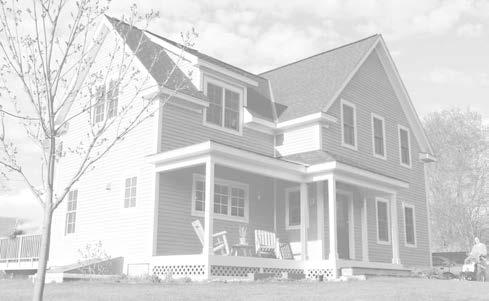
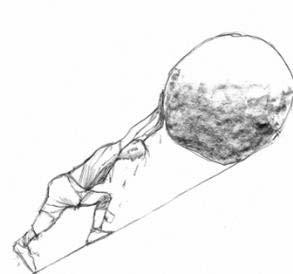




decades, he can appeal lower appellate and federal court decisions until a case is eventually brought before the Supreme Court.
All this takes time and taxpayer money, ending in numerous out-of-court settlements, the pathway Mr. Trump used as a private citizen.
However, if a case reaches the Supreme Court, only the president can enforce its decision. That’s how our Founding Fathers envisioned the balance of power. Our sixth president, Andrew Jackson, challenged the limits of the executive office, but finally complied with Chief Justice John Marshall’s decision in 1832.
president on January 20th, can now be violated. Recently, that obligation has been broken by a series of executive orders issued by President Trump sanctioned as “official acts” protected by the immunity decision.
The elected president has begun to rule with not just immunity, but with impunity and immorality.
Since then, every president has understood their allegiance to the Constitution, the checks and balances between the three branches, and their role to enforce Supreme Court rulings.
If you voted for President Trump, you voted for a lot more than a name on the ballot. You voted for a coup, and you are getting the full package. The facts surrounding the president’s life as a private citizen present a well-known package of legal entanglements and sordid, distasteful personal comments and actions. But anarchy scripted in the coup’s package is darkening our nation as the elected president has begun to rule with not just immunity, but with impunity and immorality.
care, public education, legal immigrants, climate crisis mitigation, our universities and libraries, the lRS, FDA, FCC, FEMA, EPA, DOE, HHS, HUD, DOJ, the VA, the Federal Reserve, our NATO allies and our most loyal trading partners are all examples of irrational thinking with no real end game, only producing local, state, national and world-wide chaos and destruction. Let’s call this for what is: anarchy in America.
I believe revenge is a primary reason voters elected President Trump and the reason the coup unfolded so easily and quickly. Revenge and resentment are two powerful emotions felt by millions of dissatisfied Americans.
President Trump carefully designed a well-planned campaign, identifying his version of domestic and foreign “enemies” of America, accusing them of the nation’s problems, justifying the coup. There are also those who have justified the coup expecting to profit from less regulation, privatizing government activities to their benefit. Greed and revenge have become the worst of bedfellows fostering anarchy.
ed generations of Americans? For their children’s sake, they should. Every proud, patriotic, law abiding American should as well.
Americans will not accept anarchy and living under a dictator. Resistance is growing quickly as people wake up and realize what they voted for and what is now occurring with the coup in place. Eventually, masses of patriotic Americans, long-standing institutions and agencies will refuse to obey senseless executive orders designed to seek revenge, harm others and benefit the wealthy. We are seeing signs of that push back already with growing demonstrations and increasing organizational resistance.
Punishment and retribution, the cornerstones of the president’s coup, have never been the characteristics that made America a great nation. We did not become the “shining city upon a hill” by harming legal citizens, tearing apart our government and isolating our country from the world.
President Trump can now do otherwise, showcasing the nightmare scenario feared by the architects of our Constitution. Faith and respect to that sacred obligation, as sworn on the Bible by every
The growing list of reductions and eliminations of entire federal departments and agencies, along with the dismantling of this idea of the “deep state” continue to be driven by impulsive actions, not grounded in reality, and with little thought for long-term consequences.
John Bossange lives in South Burlington. BOSSANGE continued from page 9
The war on Social Security, Medi-
or call 802-734-2928 to place an ad


The coup will last as long as the people allow it. Will Americans tire of Trump’s war on America? Will parents worry and begin to feel the pain of losing those institutions and regulations that have protect-





you saw it
Anarchy will not last because the people, regardless of their religion, race, gender, national origin or political party, will not allow the coup to stand. Democracy and America’s institutions will prevail.









continued from page 1
one day after a Palestinian man living in White River Junction, Mohsen Mahdawi, was arrested by agents from the Department of Homeland Security.


a bill, H.298, which proposes to terminate and restrict the Department of Corrections’ assistance to federal immigration authorities to the extent permitted under federal law.
















Mahdawi, who has been legally in the United States for the past decade, has been a leader in the pro-Palestinian movement at Columbia University, where he has been enrolled since 2021. Attorneys for Mahdawi assert that President Donald Trump’s administration has made clear it intends to retaliate and punish individuals like Mahdawi, who have spoken out against Israel’s military campaign in Gaza.
On April 14, Mahdawi was called in for a naturalization interview at the U.S. Citizenship and Immigration Office in Colchester and was suddenly arrested and detained, according to legal filings.
A video of the incident filmed by Vermont Sen. Rebecca White, D-Windsor, shows Mahdawi being led out of the office building in handcuffs by masked and hooded officers. He is seen in the video holding up two peace signs before being placed in an unmarked vehicle.
The memorandum of understanding stipulates that federal detainees can be housed in state prisons for roughly $180 per day, significantly less than the roughly $260 or more it costs the state to detain someone, Hinsdale said.
“I would say, pretty unequivocally, we can house Vermonters who have some kind of judicial conflict with ICE if we really felt like that was an order, like if they had a legitimate criminal charge,” Ram Hinsdale said. “We don’t need a contract with ICE to do that.”
The contract, she said, only benefits ICE in moving people quickly and without much oversight. Ram Hinsdale, who chaired the Attorney General’s Immigration Task Force in 2017, likened the current situation to that of the first Trump administration. What’s different, she said, is that the president and his cabinet are learning from their past “in a very horrific way” how to move people more quickly, she said.
“This is an all-out emergency,” Ram Hinsdale said.
Scott issued a statement after eight migrant workers were apprehended in Franklin County last month, calling on Congress and Trump to pass comprehensive immigration reform that would allow pathways to citizenship and greater opportunities for law-abiding individuals to earn a living in Vermont.
But Ram Hinsdale said this response felt like passing the buck, since there have been no concrete steps in the direction of immigration reform.
“What worries us is that it’s taken a long time for the governor to even speak out,” she said. “You compare that with other emergencies impacting Vermonters and he’s pushed for change, he’s announced fundraising efforts, you know, really, his administration has been at the table.”
While Ram Hinsdale has been vocal in her stance on the issue, other legislators have taken a quieter approach.
Rep. Brian Minier, D-South Burlington, a member of the House Committee on Corrections and Institutions, co-sponsored
“I think a fair number of us legislators knew that things were going to get very interesting at the federal level and so we were wondering what sorts of protections we could offer to Vermonters here in sort of anticipation of that,” Minier said.
He noted that in previous years, the Legislature has been successful in taking up different shield bills, like protecting gender affirming care or abortion care, out of concern about federal-level changes.
“I think it would have come to a head anyway, but then when you start seeing people grabbed off the streets, and some of them get put through Vermont, that sort of got the impetus going to take this bill down and start talking about it,” he said.
He said his committee planned to take a more low-profile approach and make a financial argument that the state was not being reimbursed enough by the federal government to cover the costs of detaining someone.
However, since the Legislature has passed Crossover — the deadline by which bills need to be passed out of their committee of jurisdiction in each body of the Legislature — the bill is likely not to be taken up this year. But, Minier said, that doesn’t mean that ideas in the bill couldn’t still be put into effect as an amendment to different legislation.
“Another question is, do you want to try to legislate some sort of carve-out such that people who are stopped here in Vermont, detained in Vermont, will be tried in Vermont? There is such a thing as court shopping,” he said, noting the federal government’s inclination to move detainees to prisons in the south. “And we have a federal judge up here who, I think, is inclined to sort of take a different view of things.”
Minier was among two other South Burlington House Reps — Martin Lalonde, D, Chittenden-12, and Emilie Krasnow, D, Chittenden-9 — who signed a resolution objecting to the manner and circumstances under which U.S. immigration authorities arrested and detained Mohsen Mahdawi and advocating that he be afforded due process under the law and released immediately from detention.
In the Senate, a bill, S.44, would require all cooperation with ICE to go through the governor.
“That would, first of all, show people that there’s one point of contact, and that is the governor, not just the Department of Corrections behind the scenes, but also not local law enforcement,” Ram Hinsdale said.
Separately, she has been working with other legislators and state treasurer Mike Pieciak on an Immigrant Defense Fund, which is set to go live in the coming weeks.
The work was also spearheaded with the help of local superintendents, like Adam Bunting of Champlain Valley School District, after several students at the school district faced threats of deportation.
“What they are doing is truly illegal at this point,” she said. “I don’t think there’s any mincing our words about that.”